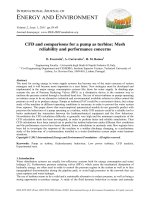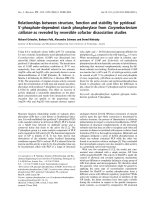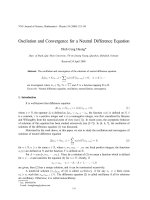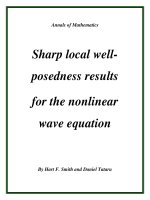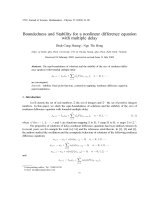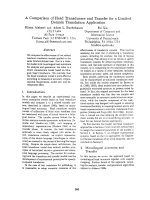Boundedness and Stability for a nonlinear difference equation with multiple delay
Bạn đang xem bản rút gọn của tài liệu. Xem và tải ngay bản đầy đủ của tài liệu tại đây (919 KB, 8 trang )
<span class='text_page_counter'>(1)</span><div class='page_container' data-page=1>
<b>Boundedness and Stability for a nonlinear difference equation </b>
<b>with multiple delay</b>
<b>Dinh Cong Huong*, Ngo Thi Hong</b>
<i>Dept, o f M ath, Q u y N h o n U nixersity, Ỉ 7 0 A n D u o n g Vuong, Q u y N hon, B in h D inh, Vietnam </i>
R eceiv ed 2 4 F eb ru a ry 2 0 0 9 ; received in revised form 11 Ju ly 2009
V N U Journal o f Science, M a th e m a tic s - P h y sics 25 (2 0 0 9 ) 91-98
A b s tr a c t. T h e e q u i-b o u n d e d n e ss o f so lu tio n s and the stab ility o f th e zero o f n onlinear d iffe r
ence eq u a tio n w ith b o u n d e d m u ltip le delay
r
i = l
are investigated.
<i>K e y w jr k : stability, fix ed p o in t th eo rem , contraction m apping, n o n lin ear differen ce equation, </i>
eq u i-b o u n d e d n ess.
<b>1. Introduction</b>
Let R denote the set o f real numbers, z the set o f integers and the set of positive integers
numbers. In this paper, we study the equi-boundedness of solutions and the stability of the zero of
nonlinear difTerence equation with bounded multiple delay
<b>( 1.1)</b>
wher;; a* for i ~ 1, 2, • • • , r and À are functions mapping z to K; F maps R to R; m maps z to
The properties o f solutions o f delay nonlinear difference equations has been studied extensively
in rcccnt years; see for example the work in [1-6] and the references cited therein. In [1], [2] and [3],
the ajthors studied the oscillation and the asymptotic behaviour o f solutions o f the following nonlinear
dilTe'cnce equations
and
<i><b>- x„ + a{n)xn-m = 0, n = 0, 1, 2, • ■</b></i>
<b> ■</b>
r
<i>X n + i - X n + ' ^ a i { n ) X n - m , </i> <i>= 0 , </i> n = 0 ,1 ,2 ,
t= l
<i><b>Xn+1 - Xn + a { n ) f { Xn - m) = 0, </b></i> <b>n = 0 , 1 , 2 , </b>
-r
^ n+1 ~ “Ỉ" m j)‘
t=l
’ Con:sponding author. Tel.: 0984769741
K-trail; dconghuongfgyahoo.com
</div>
<span class='text_page_counter'>(2)</span><div class='page_container' data-page=2>
92 <i>D C . Huong, N.T. H ong / VNU Journal o f Science, M athem atics - Physics 25 (2009) 9Ị~98</i>
<i><b>It is clcai lhal Ihcbc cqualiuiiS arc parliwulai caõcs of (I.l). \Vc diL particulail} iuctivaiwd bj ílíC work </b></i>
o f the authors [1-6] on the stability, boundedness and convergence o f solutions of difference equations.
<i>Throughout this paper, we assume that there is a A" > 0 so that if Ịx| ^ K then F{ x ) ^ /v |x . </i>
<i>If m is bounded and the maximum o f m is k, then for any integer no ^ 0, we define Z() to be </i>
<i>the set o f integers in [no - k, no]. If m is unbounded then Zo will be the set of integers in ( ~ o c, /Ỉ</i>0 -
<i>Let ĩp : Zo — > R be an inital discrete bounded function.</i>
We s a y <i>X n ~</i> <i> X r i n o r p</i> is a s o lu tio n o f (1 .1 ) i f x „ — <i>I p n</i> on Z o a n d s a tisfie s ( 1 .1 ) for <i>n > J i Q .</i>
The zero solution o f (1.1) is Liapunov stable if for any e > 0 and any integer no > 0 there
exists a Ổ > 0<i> such that \ipn\ ^ s on Zo implies \xn no </i> ^ ^ for ^ ^0
-The zero solution o f (1.1) is asymptotically stable if it is Liapunov stable and if for any integer
n o > 0 th e r e ex ists r ( n o ) > 0 s u c h th a t <i>\ ĩ p n \</i> ^ r ( ĩ i o ) on Zo im p lie s <i>\ x n</i> <b>n o </b>t/-| 0 a s n —> CXD.
<i>A solution Xn := Xnno ^ o f (1 1 ) is said to be bounded if there exists a D{riQ, ip) > Q such that</i>
Xn^no.v-I ^ <i>for 71 > riQ.</i>
A solution o f (1.1) is said to be equi-bounded if for any no and any Z?1 > 0 there exists
<i>D2</i> = i?2<i>(no, B i) > 0 such that \ĩpn\ ^ i?i on Zo implies \xn no v^l ^ </i>-^2 for 71 >
no-6 6 ’
For any sequence {xfc}, we denote: <i>Xk = 0, n </i> ~ 1
<i>k = a </i> <i>k = a</i>
2. M ain results
<i><b>2.7. The Boundedness</b></i>
<i>Lem m a 1. Assume that Xn ^ 0 fo r all n G z . Then {Xn} is a solution o f equation ( L I ) i f and only </i>
<i>i f</i>
<i><b>— ^no </b></i>
<i><b>Oi\F{xt-Tnt ) Ị j[</b></i>
<i>3-riQ </i> <i>t —no i —] </i> s = i-f I
<i>Proof. We first prove that equation (1.1) is equivalent to the equation</i>
Indeed, we have
or
a (x„ f j a; ^ ) ^ n
<b>3=no </b> <b>t=l </b> <b>s=no</b>
^ n+1 <i>~</i>
<i>3= no </i> <i>s= n o </i> i = l a = n o
X„+1 n <i>Ĩ Í K ' + j 2 < F { ^ n - m j n</i>
a=Tio s = n o i = l s = n o
<b>a (i„ </b>
n
<b>a;')= </b>
<b>n </b>
<i>x : ' .</i><i>8=no </i> <i>i= l </i> 5=no
</div>
<span class='text_page_counter'>(3)</span><div class='page_container' data-page=3>
Now, summing equation (1.2) from n o to n — 1 gives
<i>I ] a ( x , H a ; * ) - Ỵ2</i> <) n
i = r i o 5=no i = n o t = l <i>s=riQ</i>
<i>n - \ </i> r <i>t</i>
n = ^«0 + <i>Y ^ o : ịF { x i ^ ^ ,) [ ] A;^</i>
s = n o i = n o i = l <i><b>S=TIQ</b></i>
n - 1 n —1 r n —1
Xn — Xno <i>CklF{Xị-mị) </i> A3.
s = n o <i>t - n o i = l </i> s = i + l
<i>D c\ ỉĩuortg, N T. ỉỉo n g / VNU Journal o f Science, M athem atics - Physics 25 (2009) 9Ỉ -98</i> <b>93</b>
Theorem 1. <i>Assioue that An </i> <i>0 fo r n > </i>T io <i>and there exists M G (0, +oo), a € (0,1 ) such that</i>
n ~ l
s = n o
<i>ami</i>
r i - 1 <i>r</i> n —1
<b>>:</b>
> > i11
<i>i —no</i> i = l s = i + l
^ a , n > <i>uq.</i>
<i>Then solutions of (I. Ĩ) are equi-bounded.</i>
<i>Proof. I.et </i>/^1<i> be a positive constant. Choose IÌ2 > 0 such that</i>
<i>A I D \ 4“ Oí Dị ^ ^ 2 - </i>
1<i> et i/’ be a bounded initial function satisfies \ìỊ)r,\ < B\ on Zo. Define</i>
5 — {(^ : z <i>— » R|</:?n = ^’n on Zo and \\ip\\ ^ z?</i>2},
where ||v:|| inax|v::,J . We shall prove that (5, ||.||) is a complete metric space.
+ 1|.|| is a mctric.
i) v ^ , // e
<i><b>s </b></i>
<i>: </i><i><b>\\if </b></i>
<i>- 7/11 = m ax |(<^ - 7/),J > 0,</i>ri6Z
<b>m a x K v ? - 7/)„| = 0</b>
(v3 - r?)„ = 0,V n € z
<=> - r?n = 0, Vn G z
<=> (.ơn = <i>Tin, V n € </i>z
<i>o ip = 1l.</i>
ii) v ^ , ;; € 5, we have
<i>i ^ - T Ị</i> = m a x |( < ^ - r7)„
n € ^
= m ax
mGZ - r?n|
= max
n€Z r/n - yjnl = m ax |(t? - v^)„| = ||r/ - v?| n€Z
(1.3)
</div>
<span class='text_page_counter'>(4)</span><div class='page_container' data-page=4>
94 <i>D C . Huong, N.T. H ong / VNU Journal o f Science, M athem atics - Physics 25 (2009) 91-98</i>
<i>= m ax Kv? - ĩ P ) J = m£W\ifn - ^ n | = m ax \(fri - Vn + T ] n -1p,</i>
nGZ nGZ nGZ
^ m ax (!</?„ - <i>T]n\ + \T)n - ĩp n ị ) ^ </i> m ax | ( ^ „ - <i>rin \ + </i> m ax |r / „ - <i>xp,</i>
tiGZ TI^Z n€Z
= 1 1^ -^ 1 1 + 1 1 ^ - ^ 1 •
<i>+ Suppose that {(p^} is a Cauchy sequence in 5 . We have</i>
Ve > 0, 3^0 : v/c, <i>Í ^ £o : \\ự>^ - ự>^\\ < e </i>
or Ve > 0, 3^0<i> ■ v/c, £ ^ £q : m ax I</i>
n € Z <b>< </b><i>£</i>
or
< £,V n G z .
V £ > 0 , 3 ^ : V A : , 0 4 : | ( / - / )
Fixed n, {v^n} is a Cauchy sequence in K. In view o f R is a complete metric space,
<i>3>pn € R : v^„ = lim ipị.</i>
<i>i-* o o</i>
<i>We prove (f E </i>
<i><b>s. </b></i>
Indeed, since <i>e s , (pịị = 'ộn on Zo- It implies ifn = lim </i> = <i>ĩpri </i> on Zo*oo
Moreover, since llvp^ll ^ jB2, ||i^|| ^ B2.
Define mapping
<i><b>p </b></i>
:<i><b>s </b></i>
— ^<i><b>s </b></i>
by (Pi^)n = on Zo andn - l n- 1 r n—i
a—nợ t — i — a —t t I
no (1.5)
<i>We first prove that p maps from 5 to 5 . Indeed, we have</i>
<i>{ P < p )n \ </i> <i>=</i>
<i>^ </i> V’no
n- 1 n—1 r n~l
<i>i^no </i> As +
<b>n </b>
’a = n o <i>i = n o i —l </i> a = f - f l
n —1 n —1 <b>r </b> n —1
a = n o
n - 1 <b>r </b>
t=no 1=1 s=i+l
<i>Since ||<^|| ^ B2, \^ t-m t\ ^ ^</i> 2- So ^ ^ 2||v^f-mtll ^ Hence,
n - 1 r
(Pv?)„| <i>^ B y M + B i ỵ ^</i>
í= n o 1= 1
n - 1 r
t = n o t = l
<b>2</b>
n —1
<b>n /</b>
</div>
<span class='text_page_counter'>(5)</span><div class='page_container' data-page=5>
Hence
<i><b>p </b></i>
maps from<i><b>s </b></i>
to itself. We next show that p is a contraction under the supremum norm. LetV ? , <i>ri G </i>
<i><b>s, </b></i>
we get<i>D C . Huong, N.T. H ong / VNU Journal o f Science, M athem atics</i> - <i>Physics 25 (2009) 9 Ỉ-98</i> <b>95</b>
<i>[ P i p ) n - { P v ) n</i>
<i>t= n o i = l </i> 5—Í+ 1 i = n o 1=1 s = i + l
n —1 r n —1
n —1 r
<i>t= n n i ~ \</i>
<i>t=nQ</i>
^ <i>B2a \ \ <p - r i</i>
i = t + i
<i>i p - T ]</i>
Next, wc prove that <i>8 2 0 e (0 ,1). Indeed, since </i> > 0, 1 - < 1. On the other hand, from
<i>M B \ + a D ^ ^ B2</i> we have aZ?2<i> ^ B2 - M B i , which implies that</i>
<i>B2</i>
<i>This show s that p is a contraction. Thus, by the contraction mapping principle, p has a unique fixed</i>
<i>point if* € 5. We have</i>
( / V ) „ = ^ ; =
n
+ E
n A..
5 = n o i = n o i = l 5 = i - f l
n—1 n —1 r n —1
v?n = <^^0 n <i>Y ^ ( ^ t F { ^ ĩ-m t ) n</i>
5 = n o t = n o i = l 5 = i + l
i.e (/?* is a solution o f (1.1). This prove that solutions o f (1.1) are equi-bounded,
<i><b>2.2. The Stability</b></i>
Theorem 2. <i>Assume that there exists </i>7 € (0,1<i>) such that I 53 <^nl ^ </i>7 <i>l-^nl < 1 - 7 fo r all</i>
i = i
n € z. <i>Then the zero solution o f (I. I) is Liapunov stable.</i>
<i>Proof. Put</i>
</div>
<span class='text_page_counter'>(6)</span><div class='page_container' data-page=6>
Vvc iiavc
n - l n - l
X ] 1-^*1 < X ! (1 - 7) = (1 - 7)(n - no) = i\/
s —n o
n - 1 n -1
n < n ( i - 7 ) = ( i - 7 r ‘“' " ‘ = A ^
.9 = i + l
n - I n - i
I ^ A,| ^ ^ |A«| < <i>M</i>
<i><b>S=TĨQ </b></i> <i><b>s = n o</b></i>
<i>n - \ </i> <i>r</i>
^ 7 ( n - n o )
<i><b>s = n o</b></i> <b>i - 1</b>
n <i>■ y { n - n o ) N = a .</i>
<i>S—TlQ </i> <i>i ~ l </i> s —1+1
Let e > 0. Choose Ổ > 0 such that
<i>AÍỖ + a e ^ ^ e.</i>
<i>Let ip he & bounded initial function satisfies \ipn\ ^ (S' on </i>Zq. Define
5 = {(/?: z <i>— y</i> = <i>\pn</i> on Zo and ||yp|| ^ e},
9G <i>D C ỉỉiưm g, N .T H ong / VNU Journal o f Science, M athem atics</i> - <i>Physics 25 (2009) 9Ỉ-98</i>
where <i>\\ip</i> <i>= m ax (fn\ ■ It can be verified that (5, ||.||) is a complete metric spacc.</i>
Consider the map
<i><b>p : s -—►</b></i>
<i><b> s </b></i>
by (1.5). We haveVVo n A. + 2
n A
<i><b>3 —n o</b></i> i = n o i = l 5 = i - f l
<i>\ ( P M </i> <i>=</i>
^ <i>i ’no</i>
n - “l n - 1
^ IV^nol n A,, 4- X ]
<i>s —riQ </i> i —n,
^ <i>ỖM + e'^ Ỵ 2 X y “ t</i>
i = n o 1 = 1
ế <i>S M + e ^ a < e</i>
n - I r
<b>ế “‘</b>
( “ no t = l
r n —1
, n ^ no
n - l
5<b>= i + l</b>
5 = i + l
and
<i>{ P ụ ^ ) n - { P v ) n</i>
<b>n </b>—1 <b>r </b> <b>n</b>—1 <b>n</b>—1 <b>r </b> <b>r i ~ l</b>
Ể= n o t = l S=Ể + 1 <i>t = n o i = l </i> s = / + l
n —1 r n —1 n —1 r n —1
E E “ : n
<i>t= n o i = l </i> s = i + l
^ <i>e a ip — 7]</i>
n - l
<i><b>i p - v \ \ ^ e Y ^</b></i>
<i>t~ n o</i>
r n - 1
<b>>>:</b>
<b>i i</b>
<i>i f - 7 ]</i>t = l 3 = i + l
</div>
<span class='text_page_counter'>(7)</span><div class='page_container' data-page=7>
<i>D C. ỉỉiumỶị, N T. Hong</i> / <i>VNU Journal o f Science, M athem atics - Physics 25 (2009) 91-98 </i> <i>97</i>
<i>I’heorcm 3. Assume that the hypotheses o f Theorem 2 are satisfied. Assume, in addition, that</i>
<i>n — ĩìin </i> <i>OQ as n </i> <i>oo. </i> (1.6)
<i>Then the zero solution o f ( L I ) is asymptotically stable.</i>
<i>Proof. Since |A„| < 1 - </i>7 for all n € z and 7 e (0 ,1 ), it follows that |An| < 1. Consequently,
<b>n -i</b>
(1.7)
5=no
<i>Let 0 be a bounded initial function satisfies \'ipn\ ^ r(n o ). Define</i>
<b>5</b><i>* ~ { if </i> <i>^ K|v^n — 'ộn on Zo, lls^ll ^ ể: and ịọnị “ ^ 0 , as n —►</i> oo}.
<i>Define p : </i>
<i><b>s* </b></i>
— ►<i><b>s* </b></i>
by (Ĩ.5). From the proof of Theorem 2, the map p is a contraction and it maps<i>from s* to itself.</i>
<i>We next prove that {Pựĩ}n goes to zero as n goes to infinity.</i>
n — 1
<i>Since (1.7), it follows that xpno </i>
n
goes to zero as n goes to infinie. We have only to prove<i><b>3=no</b></i>
<b>ri—1 </b> <b>n—1</b>
E E [=1 ữỊF(v?t-m ,)
n
<i>A^, (n > no) — > 0 as n — > oo. Let ip € s* then \^pn-m„ \ ^ £• Also, </i>since 0 as n - 7TI„ —^ oo, there exists a n i > 0 such that for n > <i>T il, \ ( p n - m I </i> < i^i for
> 0.
<i>Indeed, by the condition (1.7), there exists n-i > ri\ such that</i>
<b>s=ni</b>
< Vn > no.
<i>ĩe n c e . fo r all n > U</i>2, w e h a v e
n - l r n - I n - 1 r n ~ l
<i>t=-no t = l </i> S - Ể + 1 <i>t - n o t ™l </i> + l
r n - 1 n —1 r n —1
<i>'^ ^ a lF { ip i-r n t) n</i>
<i><b>i = \ </b></i> <i><b>s - t - j - l</b></i> <b>i " n i i = l </b> <b>a = i + l</b>
r n —1 n —1 r n —1
n
+ ‘ ? i : E “ i n ^
i = l i ^ n i i = l s = i + l
r n i —1 n —1
i = l s = i + l 5 = n i
<b>ni -Ỉ</b>
<b>i=no </b>
n i - 1
<i>t= n o </i>
n i ~ l
<i>t ~ n o </i>
<i>n —\</i>
<i>S = T l ị</i>
<b>n-1</b>
<b>«1-1</b>
Ể=no
<b>Ẻ»:</b>
i = l<b>n i - 1</b>
<b>n /</b>
<b>s=i+l</b>
<i>+ e \ a</i>
<i><b>ế e^a</b></i>
S = Hị
</div>
<span class='text_page_counter'>(8)</span><div class='page_container' data-page=8>
<i>Nov/, by the above, it follows that {Pi^)n - ' 0 as u - r Oo. </i> <i>the coiitiacliuii iiiappiiig piiiiv-iplc, p </i>
has a unique fixed point that solves (1.1) and goes to zero as n goes to infinity. The proof is complete.
<b>A c k n o w le d g e m e n t. The authors would like to thank the referees for useful comments, which </b>
improve the presentation o f this paper.
<b>References</b>
<i>[1] R.p. Agarwal, Difference Equations and Inequalities. Theory, Methods, and Applicationsy Marcel Dckkcr Inc 2000.</i>
<i>[2] B.s. Lalli, B.G. Zhang, Oscillation of diíTerence equations. Colloquium Mathematicum Vol. LXV (1993) 25.</i>
[3] Dinh Cong Huong, On the asymptotic behaviour of solutions of a nonlinear diíĩercnce equation with bounded multiple
<i>delay, Vietnam Journal o f Mathematics. Vol 34 (2006) 163.</i>
<i>[4] Dang Vu Giang, Dinh Cong Huong, Extinction, Persistence and Global stability in models of population growth. J </i>
<i>Math. A nal A p p l 308 (2005) 195.</i>
<i>[5] Dang Vu Giang, Dinh Cong Huong, Nontrivial periodicity in discrete delay models of population growth, J. Math. Anal. </i>
<i>Appi. 305 (2005) 291.</i>
[6] Dinh Cong Huong, Phan Thanh Nam, On Oie Oscillation, Convergence and Boundedness of a nonlinear diffcrcnce
<i>equation with multiple delay, Vietnam Journal o f Mathematics 36 (2008) 151.</i>
</div>
<!--links-->
